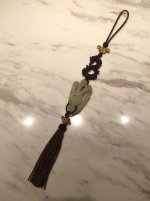Hey David!
To begin with, these pieces are most definitely going for the asian vintage style look. There are also plenty of pieces mounted in white gold and diamond and such, and they just look like contemporary pieces.
With the salvaged bronze parts, they are just no longer produced these days. The designs & metals used for findings these days (at least on the more commercial level) are becoming poorer. Some of the salvaged parts also have a slight patina look to them (not sure if that's the correct way to describe the look).
In terms of Jade, it is quite a large category to cover. Disclaimer - these are just my personal rough understanding - I'm not in the industry so could be misquoting a few things here.
In terms of old vs new - there are most definitely still a lot of jade being mined these days. But unless mined for high end fine jewelries, similarly to findings, the quality/carving these days are becoming poorer. And there are also older vs newer mines, where some of the older mines are more prized and becoming depleted these days.
There are also 2 main categories of jade - in the neolithic period, most of the jade in China are nephrite, which are a lighter creamier colored white jade, also known as mutton fat white jade. It is used both for jewelry, as well as festival/ceremonial purposes.
The greener jade, which has taken over the reference/definition of jade these days, are not introduced to China until later in the 1800s and mostly mined in Myanmar. It is mostly used for jewelry purposes. Green is the most sought after color, however, this category of jade also exist in white, orange, and lavender colors. The top grade of the green is called Jadeite, which is highly and evenly saturated in the brightest and most vivid green. Chinese people say these type of green is a bit oily & watery.
Hope this helps!


